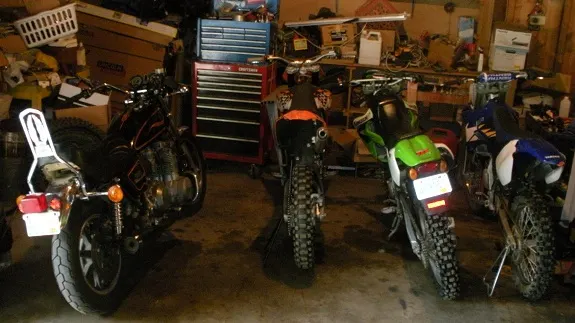For those of us that don't live in the southern states, unfortunately, we have to Winterize our dirt bikes and most other motorized toys. That also means we have to de-winterize them as well once Spring rolls around. We'll look at all the steps you need to do to prep your dirt bike for the upcoming riding season.
This can also be helpful if you have recently bought a dirt bike that has been sitting in someones barn or garage for years and it needs to maintenance to get it running again.
Wash It
Yes, I know it may just be dusty, but unless you thoroughly washed it before you put away last fall, it's a good idea to scrub everything down. You will see the effect of this years down the road; your dirt bike will still look like new (besides the worn paint), but others will have crusty, oil-stained, dirt-colored bikes. This is usually on the bottom of bikes, but if you take care of it, then it will be easier to sell in the future.
Clean The Carburetor
Dirt bike carburetors often get dirty and gummed up from sitting for a couple months. Even if you can get the bike to start up, chances are is that it's not going to run right. The cheapest way to fix this is with a
carb cleaner and an air gun. You should pull all of the jets out and thoroughly clean them. The smallest amount of dust can cause problems, even if you can't see it. Then you'll want to spray in the carb through all of the passages. It may take a couple times to clean everything out.
Click here for a full article on how to clean a dirt bike carburetor.
The more expensive, yet much more effective way, is with an
Ultrasonic carburetor cleaner. These were originally used for cleaning small jewelry items, but the half gallon tank can clean dirt bike carburetor parts, as well as injector parts (for you FI guys). It uses special liquids with an ultrasonic frequency that washes away all the dirt, grease, and grime off of parts. Just stick your parts in the tank and let them sit in there for a few hours and they're good as new!
Change Oil
After sitting for a while, oils and liquids gather dirt and impurities. It's best to drain the old fluids and put in some new oil. You don't want your engine to lock up on your first ride of the season when it could have been prevented with $10 of oil.
Change Filter(s)
Air filters should be cleaned/replaced every few rides, and sometimes sooner, depending on the riding conditions. It protects the engine by keeping dirt and other foreign materials out of the carburetor. Dirt is an engines worst enemy, so don't forget to clean the air filter. This goes for the oil filter as well, as it collects impurities in the engine oil. The oil filter on a four-stroke should be replaced every other ride. They're dirt cheap (no pun intended), and will prevent a major failure later on. Two-strokes don't have oil filters, so that's one less thing to maintain.
Lube Chain
If you want your chain to stay in one-piece, lube it up before you go on your first trail ride or moto session. A rusty chain can and will cause problems sooner rather than later. I don't think I need to go into much detail, but a broken chain can blow a hole through the left side of the crankcase...
Fresh Spark Plug
A fouled plug is one of the worst problems that can happen on a long trail ride, especially if you forget to bring a spare. You should replace your
dirt bike's spark plug at least once a year. Not only does it give the bike more power compared to an old and fouled plug, but it will start and run much better. Don't forget to pack spares!
Oil It Up
If you live in a relatively humid environment and your bike has been sitting for more than a couple months, there's a good chance the cylinder walls have started to rust on the surface. This can be really hard on it and the piston rings on the first start up. To reduce the chances of a failure and damage, pull the spark plug off and pour a light amount of oil down to the cylinder. Then, slowly kick the bike over to get the oil to cover the walls.
Fresh Gas
Yes, technically this is number eight, but it's very important. Gas goes bad fairly quickly, especially if it has additives or premix. So, drain all of the gas out of the tank and/or carb if you haven't already, and put in some fresh gas. Old gas can and will cause problems, especially on higher performance bikes that require fine carb-tuning.
If you've completed all these steps on how to de-winterize your dirt bike and your dirt bike doesn't start, read my guide on diagnosing a no-start situation here.
How to become a better & safer rider
Once you get your bike up and running after it's been sitting, it's time to learn how to properly ride it so that you stay safe and don't have any big crashes. I want to help you out, so click here to quickly learn the basic techniques to stay in control off-road.


